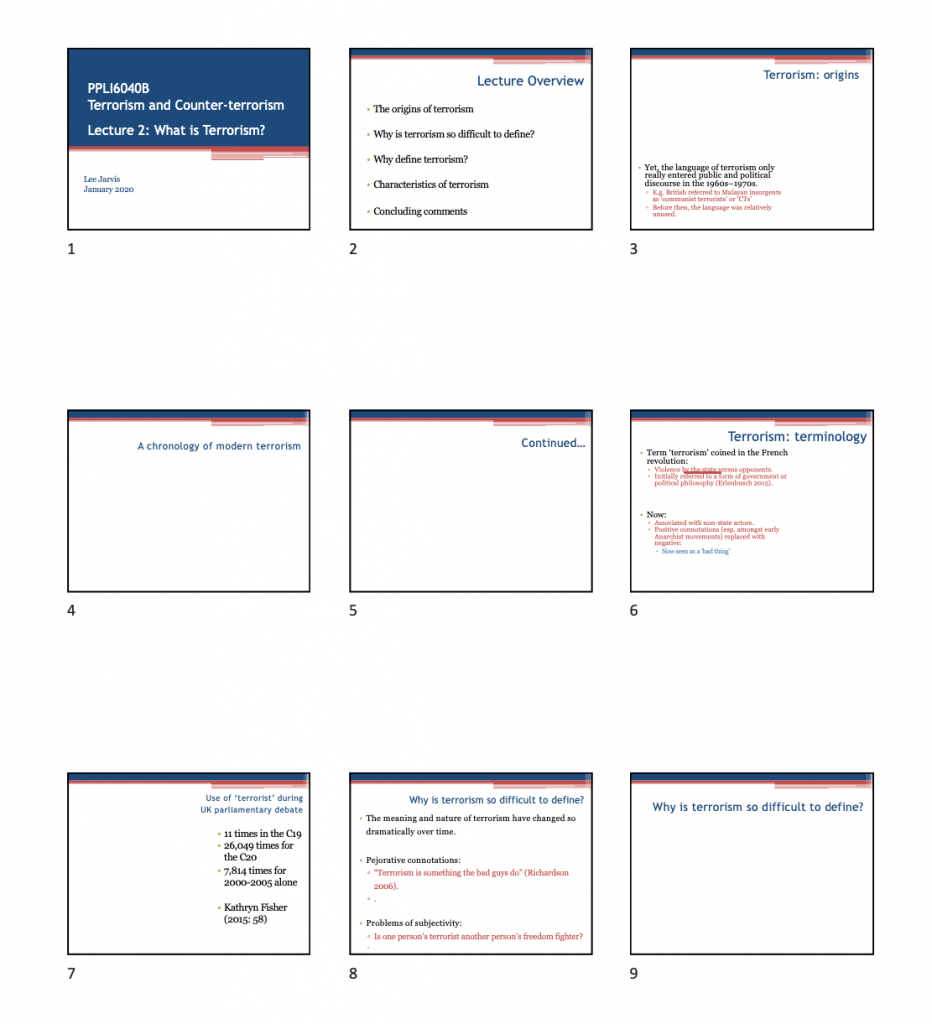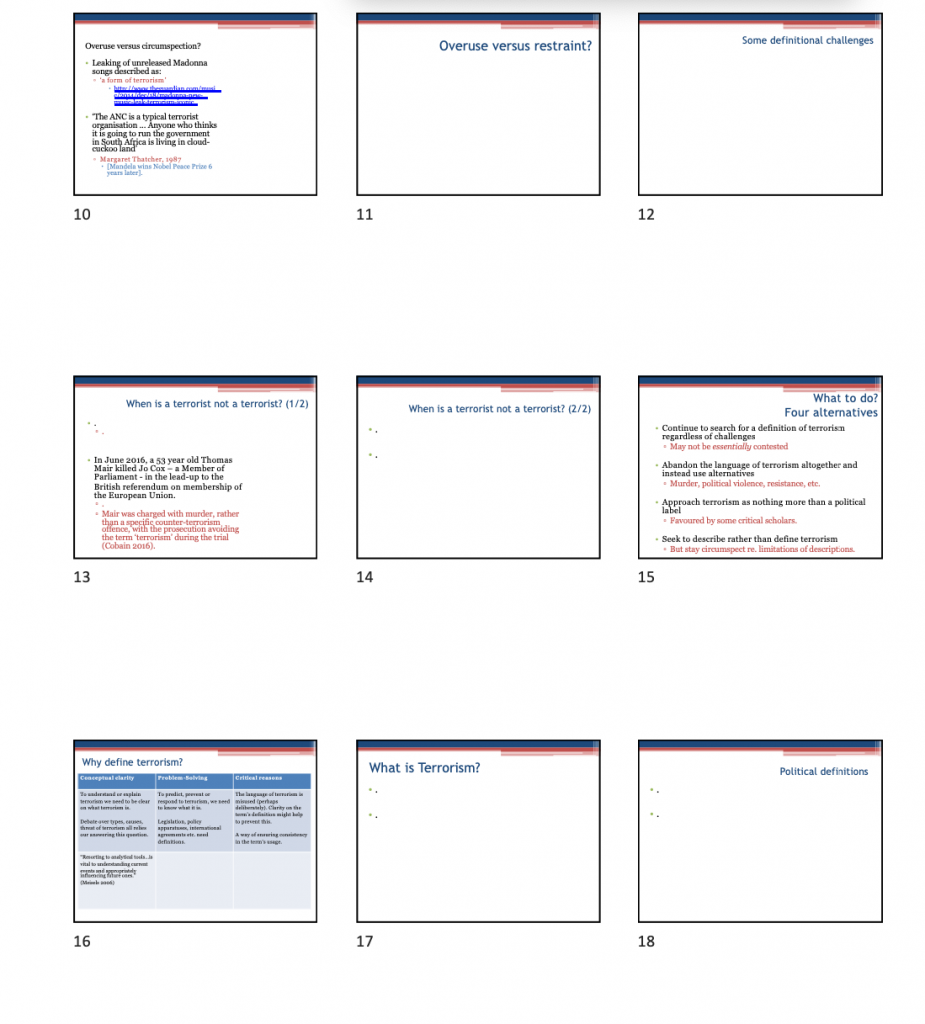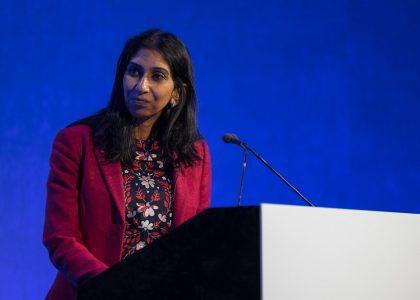What would your lecture slides look like if you removed male authors? Professor Lee Jarvis had a look at his to find out.

Like many of my colleagues, I have spent the last few weeks preparing for, and thinking about, my teaching for this semester. This year I’ll be delivering two modules: an undergraduate course on terrorism and counterterrorism, and a postgraduate course on international security. Amongst other activities my recent work has involved updating module guides and reading lists, revising seminar material, and – of course – producing new audio and visual content for online delivery (academics are rumoured to rather like the sound of their own voices. I, increasingly, do not!)
An increasingly, and rightly, prominent focus within this work relates to issues of representation, diversity and equality. For me, this involves asking whether my teaching adequately addresses theories, issues, case studies, and scholars typically excluded from the academic fields in which I work (fields that remain dominated by specific types of approach, and specific types of scholar). This is a topic about which I think frequently, and – I am sure – a topic on which I could do more.
This year, putting my finishing touches to these teaching materials, I found myself reflecting on some of my recent efforts to offer a more inclusive, and engaging, curriculum. [Here – I’m aware – comes the ‘case for the defence’ moment, so bear with me!]. These efforts have included:
- Focusing on articles written by female scholars in a weekly online discussion forum.
- Providing students with a standalone introduction to the work of prominent female researchers.
- Giving space to issues of gender, race and religion within both modules.
- Shuffling the order of material on module guides, so – for instance – feminist and postcolonial work arrives much earlier than would be typical, and more traditional approaches arrive later.
- Incorporating new reading lists and material on topics including race and queer theory.
- Including coverage of topics such as imperialism, state terrorism, and gender-based violence in my teaching
In some ways, attempting such work is easier in my teaching than it might be. Each of my modules has a significant focus on critical approaches, and the textbooks we use are – I think – more sensitive to these questions than some alternatives (although I should declare an interest here, as I helped to write both books!).
It was while thinking about these efforts, their adequacy, and their problems, that I listened to a podcast in which Dylan Marron described his Every Single Word project. The project involved editing the dialogue of films to include only the words spoken by actors of colour. It’s a fascinating idea, and I strongly recommend having a look at it, and the videos it produced.
Listening to the podcast, I started to wonder: what would my ‘content’ look like if I attempted something similar? How would my lectures, for instance, appear if I removed the words of – say – white authors, or male authors? How much prominence do I give, in my teaching, to the research and ideas of scholars of colour, to female scholars, or to working class authors? What blank spaces, silences, or exclusions shape my engagement with my students and my research material?
And, so…
For my own curiosity, really, I took inspiration from Marron’s project, and had a go at editing down the powerpoint slides for one of my lectures: a lecture that was delivered last year on the definition of terrorism. This must have been done by someone before, but I couldn’t find any examples online, so I thought I would share mine.

I decided to look at gender, initially, and therefore removed all discussion of, and all reference to, work that seemed to be written exclusively by male authors. For this, I relied on names and pronouns – but my sincere apologies if I have erred here: I’ve no interest in, or intention to, cause offence. For other reasons, I removed all images from the slides – which, of course, speak to and provide meaning alongside the written text. I should also say that I don’t lecture from a written script, so my delivery will certainly have wandered from, around, and back to the text on these slides.
You might be surprised how much time I spent deciding whether to write this up in what seems an imprudent moment to draw attention to one’s limitations. In the end, though, I went for it, and here’s what I found…
First, because the module textbook from which this lecture draws was co-authored with a female colleague, the edited version of these slides is perhaps not as damning as it could be. I did try to be as self-critical as possible, and so took out any material without an explicitly gendered author (e.g. government definitions of terrorism, or policy statements from media corporations). But – to be blunt – I was fearing worse.
Second, the above notwithstanding, there is – clearly – a lot of blank space on my newly edited slides. Of the 27 slides that make up the lecture (with hindsight, this seems rather a lot!), a full eleven now have no text at all. Although I have left their titles in place to indicate the material we cover, these slides are blank once stripped of male authorship.
Third, it also became clear to me that my students would not necessarily know whether the work discussed in my lecture was authored by male or female writers. I tend not to include photographs of academics on my slides, and I tend only to include surnames and years in the written references I provide (often expanding on these in my spoken words). There might be advantages to this approach or perhaps to that ignorance. But it might also – of course – work to camouflage or hide biases such as those that become evident from this sort of activity. (Unreferenced material on the slides draws on the course textbook).
All of this matters, I think, because our lectures constitute the things they claim to represent. My lecture, on the definition of terrorism, will be for many of my students their main – or perhaps even their only – engagement with this topic. The material included on these slides – for those students – is the material. What I choose to include – and also, therefore, what I do not include – becomes, again for those students, an authoritative depiction of the topic, its key authors, and its debates.
What, then, can – or should – I do with this knowledge in my teaching going forwards? One response could be to attempt to remove any blank spaces from future lectures by ensuring there is some representation of female scholars – or other marginalised groups – on every slide. Another would be to be more explicit in explaining my decisions underpinning the examples and references I give (and the possibility of alternatives to all of these). I could replace the voices of white male scholars with those of other authors, making related or, indeed, different arguments. I’m sure there are many other alternatives too – and I need to spend more time thinking about this and listening to others.
I should be clear – I am not an expert on gender (or race), although I have written a little about both. Nor am I an expert on pedagogical issues around diversity and equality. I have, however, been teaching security and terrorism for a number of years now. And, I am genuinely interested in how those subjects can best be taught to provide a diverse and inclusive learning environment for our students. I don’t know how representative these particular lecture slides are of my own modules, or – indeed – of other modules. My suspicion is that my slides on ‘gender and terrorism’ (currently taught in a standalone week, I know…) might look rather fuller. My teaching of other material, though, might be even more dominated by male authors and therefore rendered more blank in an exercise like this. Moreover, although I have not yet done it, I’m almost certain that a similar exercise focusing on scholars of colour in my lectures would generate a more disappointing result.

At the very least – and, perhaps, selfishly – this exercise this has given me an opportunity to think about, to reflect on, and to share my own silences and exclusions: to bring forward and make visible previously hidden blank spaces. I don’t know how useful this exercise will be to me (or to others), and I am sure I could have done this differently, perhaps more thoroughly, with more time (for instance by similarly editing the module reading list). I am, however, fairly confident that the experience will come back to me when I next sit down to work on a lecture, which – I hope – is a start.
Lee Jarvis, Professor of International Politics, University of East Anglia




